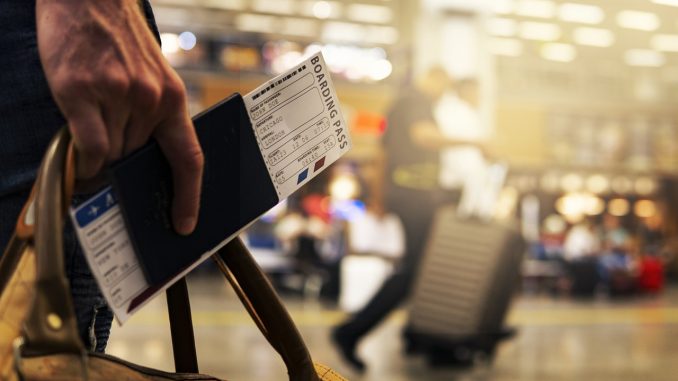
If 684,000 bags were lost or mishandled by a prominent US airline in 2022, as reported by Luggage Hero. Now, let your mind wander—what could the figures be like worldwide?
In this article, discover foolproof techniques to safeguard your belongings during transit, sparing you the nightmares of missed schedules and disrupted plans.
While travel insurance offers some peace of mind, it’s crucial to equip yourself with invaluable tips on how to avoid losing your luggage in transit.
Take one Way Flight
When it comes to avoiding lost luggage, booking a one-way flight can be a reliable strategy.

While it may be more expensive, it significantly reduces the risk of your luggage getting lost or mishandled.
Alternatively, you can consider opting for extended layover packages, but be cautious and choose layover times of at least 1.5 hours to minimize the chances of losing your baggage.
Mark Your Luggage
Amidst a sea of similar-looking suitcases, it’s important to make your luggage stand out. Get creative and use tape or stickers to design distinctive characters or apply bold colors on your luggage.
This will make it easier to spot your baggage and reduce the likelihood of it being mistakenly taken by someone else. If you lack inspiration, consider investing in a striking-colored suitcase.
Arrive on Time
One effective way to prevent luggage loss is by arriving at your destination on time. As soon as you arrive, head directly to the luggage terminal to track your baggage.
This allows you to have a clear overview of what has arrived and what is still in transit. If you can’t locate your luggage, don’t hesitate to ask airport staff for assistance.
Being punctual can greatly increase the chances of recovering your belongings.
Mark Your Luggage Inside Out
An ingenious method to safeguard your luggage is by implementing an in-and-out verification system.
Attach external tags or labels with identifiable information, such as “this is my XYZ,” to your luggage.
Additionally, place a piece of paper inside the luggage in an easily noticeable position.
In case the external information falls off, the inside details can serve as proof of ownership and aid in the recovery process.
Get Rid of Old Tags
If you frequently travel with different airlines, it’s essential to remove any old tags from your luggage.
These tags may cause confusion, as they may display the logo of a different airline than the one you are currently using.
By eliminating old tags, you can streamline the recovery process in the event that your luggage is lost and needs to be located.
Use Pictures
Including a clear picture of yourself and your contact information on your luggage can greatly assist in the recovery process if your luggage goes missing.
By attaching a photo and your current address, phone number, or email to your luggage, you provide airline staff with visual identification and essential details to locate you.
Use Padlocks
To enhance the security of your luggage and minimize the chances of losing valuable items, it is advisable to use sturdy padlocks.
By securing your bags with portable and presentable padlocks, you can deter theft and ensure that your belongings remain intact throughout the journey.
Use a Luggage Tag
One of the easiest and most effective ways to identify your luggage is by using a luggage tag.
Modern luggage tags often come with GPS tracking capabilities, enabling airline services to locate your bag precisely.
Additionally, you can install a GPS tracking device on your smartphone to monitor your luggage’s whereabouts and provide accurate information to the airline if needed.
Popular options for luggage tracking devices include Tile Pro Powerful Bluetooth Tracker and galaxy smart tags.
Pack on What you Need
When it comes to luggage, packing smart is key to avoiding losses. Pack only the essential items you will need during your trip, such as important documents, travel essentials, and necessary clothing.
Avoid overpacking, as it can lead to unnecessary bulk and make it difficult to keep track of your belongings.
Prioritize the items you truly need to minimize the risk of losing them during transit.
What if?
In the unfortunate event that your luggage does go missing despite taking preventive measures, it is essential to know what steps to take.
Contact the appropriate authorities at your airline service provider who are responsible for lost luggage.
Provide them with detailed information about your missing baggage, including its description, contents, and any distinguishing features.
They will guide you through the process of reporting and recovering your lost luggage.
FAQs
How can I make my luggage stand out?
You can make your luggage stand out by using eye-catching details such as bright colors, ribbons, duct tape, stickers, patches, or bold luggage straps. These unique markings will help you identify your bag on the carousel and prevent others from mistakenly grabbing it.
Is using smart locks an ideal?
Using TSA-approved locks adds an extra layer of security to your luggage. It helps prevent theft and ensures the safety of your belongings during the journey.
Why is it important to get to the baggage claim area quickly?
Getting to the baggage claim area quickly allows you to keep an eye on your bag as it comes off the belt, reducing the risk of someone accidentally or intentionally picking up your luggage.
Conclusion
While there is no foolproof way to prevent lost luggage, following these tips can increase the chances of keeping your bags safe during travel.
By taking proactive measures such as flying non-stop, making your luggage stand out, labeling your baggage, removing old tags, taking pictures, using locks, and being vigilant at the baggage claim area, you can reduce the risk of lost or misplaced luggage.
However, it is always recommended to keep essential items, valuables, and a change of clothes in your carry-on bag and consider getting travel insurance to cover any potential losses.